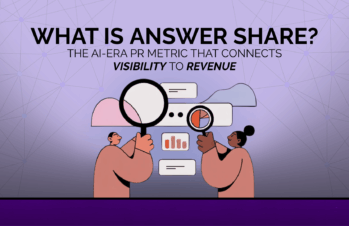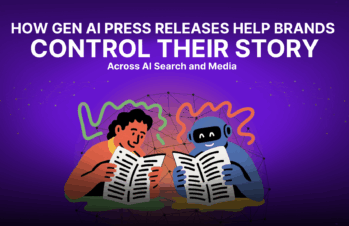Your brand has a face. It’s shaped by the graphics, colors, and fonts that create your logo and show the world exactly who you are and what you do. Your brand also has a personality that comes across in its appearance, as well as the messaging, tone, and content you share. This is where B2B brand management comes in.
Getting your brand’s face and personality to come together and deliver a cohesive story is brand management. It’s the work your marketing team puts in to maintain your company image across advertising, social channels, media, and with your customers and stakeholders.
Brand management helps you stand out from the competition, share exciting news, and navigate challenges; it propels your team to work toward a common goal.
In short, brand management is the driving force for setting clear business goals, figuring out who your target audience is, and discovering the best ways to reach them.
And in order to do well in business, you have to put your best face forward. Brand management is the guiding light behind your marketing communications. It determines your brand identity, strategy, positioning, content marketing, digital strategies, customer support, and crisis communication. With a robust branding strategy in place, you can establish customer trust and a strong presence in your industry.
Understanding B2B Brand Management
For B2Bs, brand management is the north star behind every decision regarding the brand. Content marketing, digital strategy, and customer feedback play critical roles in brand management.
This guide will define the key elements of a brand management strategy and identify areas for improvement.
Differences Between B2B and B2C Brand Management
In B2B, brands must build trust and credibility over a long period of time to match the buyer journey and directly address customer pain points with customized messaging. B2B brand management also heavily relies on thought leadership and seeking out opportunities to demonstrate your brand’s expertise, industry knowledge, and the value you provide for other businesses. In B2C brand management, the focus lies in finding ways to appeal to a mass audience.
Both B2Bs and B2Cs require consistent messaging, a deep understanding of your target market, and maintaining customer satisfaction, but B2B buyers are motivated by tailored messaging and content that educates and provides solutions to their challenges. Keep these distinctions in mind as your company works to find the marketing strategies to shape your brand and remain competitive.
The Role of Brand Identity in B2B Marketing
Developing a strong brand identity is rooted in the logos, color schemes, and messaging you create for your brand. Take Google, for example. Once a simple search engine, Google now owns more than 91% of the global search engine market. Its transformation into a major powerhouse and knowledge source made the brand a regular part of our daily lives. From technology to YouTube and email, Google spans a wide range of use cases.
The word ‘Google’ wasn’t even part of our regular lexicon before the brand’s launch in 1998, but it’s now a verb that gets causally dropped into conversation. Google’s brand identity is simple: A collection of four primary colors set against a white background, taking on the shape of the brand’s products and services to easily show users what to expect.
In B2B, messaging platform Slack uses a similar color palette and design to express communication and collaboration. The brand’s slogan, “Where work happens,” succinctly sums up its purpose to connect employees. It even allows organizations to customize channel names and third-party integrations to align the platform with their specific workflows.
Even if your business uses another communication platform, you’re likely familiar with Slack, Microsoft Teams, or Zoom—and that’s the power of brand identity. You don’t need to know everything about the brand to have a general understanding of what the brand does. With a strong brand identity, you’re more likely to raise awareness and close sales.
This is because customers respond to consistency. In fact, 75% of consumers expect to receive a consistent brand experience across channels. Consistency from channel to channel not only builds trust, it makes your brand easily recognizable. And when customers see the same logos, colors, and taglines that shape your brand, they are more likely to remember you and reach out during the research phase of their buyer journey.
Building a Brand Strategy for B2B Markets
Your company invests a lot of money in building your brand, but when only 6% of consumers reportedly remember at least half of the ads they see in a day, it’s important to create a strong brand identity that truly stands out and leaves an impression.
As noted above, consistent brand messaging plays a critical role in forging long-term relationships with your customers, increasing brand loyalty, and driving conversions. Building a brand strategy in B2B requires you to set clear brand objectives and goals, identify your target B2B audience and their needs, and create a unique value proposition (UVP).
Set clear brand objectives and goals. Is your brand focused on the environment or technology? Use colors and symbols that represent those industries and find ways to work them into a logo or tagline that effectively communicates your brand’s mission.
Identify your target B2B audience and their needs. What are your audience’s pain points? What motivates them? How can your brand provide solutions? Conduct research and request feedback from current and potential customers to identify gaps in your products or services, and find ways to address those needs with content marketing that aligns with your brand strategy.
Craft a UVP. What does your brand bring to the table and how does it differ from the competition? B2B buyers are looking beyond trends and empty promises. They want to see long-term results and positive messaging from customer reviews, trusted publications, and brand partnerships to see how your products and services will meet their needs.
Effective B2B Brand Positioning
What do you ask for when you want a dark, fizzy drink: a soda, or a Coke?
Do you say you’ll schedule a Zoom meeting even though you use another platform?
How often do you “Google” something?
Brand positioning refers to the recognition a brand carries. Strong brands often replace the generic words or phrases they refer to. This is a product of brand consistency, or how often we see and recognize brands for what they do.
How can your brand adopt an effective brand positioning strategy in a competitive market? Start by defining your current brand positioning and naming your competitors. Look into their brands and compare your strengths and weaknesses against theirs. Do you see any gaps? If so, look for ways to fill those gaps to present solutions for your target audience.
This creates value and helps you elevate your brand while also creating a strong connection with your current and prospective customers. Create a brand positioning tagline or statement that embodies your brand and ensure your content and customer-facing employees repeat your positioning across every interaction.
Need more inspiration? Explore three examples of successful B2B brand positioning below.
IBM
As one of the most widely recognized B2B brands on the planet, IBM presents marketers with constant sources of inspiration to shape their brand positioning strategies. Even with younger, flashier competitors like Google and Oracle closing in, IBM remains a strong choice in technological innovation. IBM’s previous brand positioning focused on “cognitive business,” or the ways AI and big data processing would impact its businesses. The current positioning? Co-creating. Not only does this serve as a way to unite brands with their clients and partners, it shows that IBM will continue to innovate and platform creativity.
Cisco
Another big name in tech, Cisco has been a giant in the cloud space for a while. Major competitors include Huawei and Amazon for this brand built on communication. It’s current brand positioning emphasizes connectivity in communication to “create a world of potential.” In its next phase, Cisco recognizes a growing need for the brand to innovate and adapt to use cases fueled by AI, sustainability, and hybrid work, showing that the brand is already primed to meet the future needs of its customers.
The leader of the B2B social scene, LinkedIn has transformed from a job posting site to a networking portal that connects everyone from employees to job-seekers to recruiters and C-suite executives. Not only has LinkedIn curated an ideal professional social networking feed, it invites its users to share their insights with fireside chats and virtual live events. The platform has even seen a rise in influencers. As more and more brands turn to micro influencers with fewer than 100,000 followers and niche markets, LinkedIn will continue to play a role in elevating thought leadership content for brands.
Content Marketing and Brand Awareness
Content marketing is the umbrella term for the creation and sharing of digital materials designed to draw customers to your brand. Content marketing is a powerful tool for B2B brand management that allows companies to establish themselves as thought leaders in their industry and build trust with potential customers.
Creating valuable, engaging, dynamic, and informative content is an effective way to boost brand awareness and connect with a wide range of audiences. Types of content that resonate with B2B audiences include blog posts, contributed articles in trusted publications, e-books or white papers, surveys and reports, podcasts, webinars or live streams, social media posts, visual content (infographics, videos, and images), and interactive content (quizzes, polls, maps, and charts).
Related read: The Ultimate Guide to Content Marketing for B2B
Digital Marketing Strategies for B2B Branding
Creating the content is one thing, distributing it effectively is another. In order to maximize brand awareness, companies must use a variety of digital marketing strategies to reach current and prospective customers and drive website traffic. This includes email marketing campaigns, social media, public relations, and search engine optimization (SEO) strategies.
Tailor SEO strategies for B2B brands. SEO improves your brand’s visibility by boosting your ranking on search engines like Google. B2B brands can improve their SEO by conducting keyword research to identify the terms and phrases your competitors and target audiences are searching for in relation to your industry, products, or services.
Keyword optimization can also determine the type of content you create and establish your brand as a trusted source. Optimizing your website for mobile users and backlinking to reliable sources across your content will further improve your brand’s SEO rankings.
Leverage public relations and social media to enhance brand visibility and engagement. Public relations and social media are two more ways you can push your brand in front of your target market and reach new audiences, but you must understand how to leverage them separately and together.
B2B PR involves more than drafting press releases or landing interviews. A strong PR strategy includes thought leadership, media and influencer relations, and media monitoring to establish your brand as an industry leader and fit into the media landscape.
Social media allows you to market your brand’s products and services across relevant channels. It can help you engage with customers, boost your brand reputation, increase customer loyalty, and improve your customer experience. Use social media to amplify and extend the life of your PR wins, connect with relevant influencers, and generate more content.
Strengthen brand recognition through email marketing campaigns. Targeted email campaigns are an effective way to directly engage with your audience. Inform customers of product launches or updates, remind them to replace or refresh their products, and share relevant industry news. You can really tailor email marketing, segmenting your outreach based on customer preferences or behaviors to improve click-through rates, nurture leads, and drive conversions.
Customer Experience (CX) and B2B Brand Loyalty
When was the last time you received poor customer service from a brand and switched to their competitor as a result? It’s happening at high rates across industries, with 73% of consumers reportedly switching to competitor brands after multiple bad experiences. This statistic, paired with the fact that new brands arrive on the market all the time, proves the value in providing a positive customer experience to determine brand loyalty.
Strategies for improving CX to build a loyal customer base include understanding the customer journey, providing personalized experiences, delivering consistent results, and communicating effectively.
Measuring Brand Equity in the B2B Sector
Brand equity refers to the social value of your brand. In other words, is your brand name well known? Is it easily recognizable? The more awareness around your brand, the more likely customers are to choose your brand over competitors, which can lead to an increase in brand equity. Elements like a memorable logo or tagline can help create brand awareness, as can a reputation for providing a good customer experience.
Customer loyalty and brand awareness are two ways to measure brand equity, but the perceived quality of a brand and its brand associations can also help. These elements come together to determine how often customers will consistently choose a particular brand. For B2Bs, this might look like repeat purchases, contract renewals, and referrals. While brand awareness is less quantifiable, brands can get an idea of their equity by monitoring social media mentions, website traffic, and SEO rankings in conjunction with market research, analytics tools, and customer engagement data.
Customer reviews, testimonials, and industry awards determine perceived quality, while qualitative research, social media sentiment analysis, and customer feedback measure brand association. When B2B brands tap into social media monitoring, customer feedback, brand audits, market research, and analytical platforms, they can better manage their brand, identifying areas for improvement and optimizing their digital marketing efforts to enhance brand visibility, engagement, and loyalty.
Crisis Management and Brand Reputation
Unfortunately, crises happen and they can taint a brand’s reputation. On the bright side, you can be prepared with a crisis management plan. This involves considering all of the potential risks, vulnerabilities, and challenges your organization might encounter and categorizing the scale of damage that might occur. This could include anything from a negative online review to a data breach.
There are three key phases to consider when putting together your crisis management strategy: the pre-crisis phase, response phase, and post-crisis phase. Think about the different scenarios, responses, and steps you should take to mitigate the issues during each phase. By anticipating these potential crises and their lifecycles, a company can be better prepared to respond effectively if and when they occur.
Best Practices for Managing and Recovering from a Crisis
Putting together your crisis management plan is an effective first step in preparing for and recovering from a crisis. You must also identify a crisis management team and key stakeholders. Your biggest asset? Communication. Know who’s saying what on which channels and when. Have a strong internal communications plan in place to effectively communicate externally.
Focusing on your company values during a crisis is critical to maintaining consistency in your messaging and affirming your identity to stakeholders. Respond quickly, but thoughtfully; you’ll want to ensure your messaging covers necessary information in a timely manner while remaining empathetic, compassionate, and understanding.
Once the crisis is over, conduct a thorough analysis of your handling of the situation to gauge sentiment, identify areas for improvement, highlight what went well, and learn where to focus your efforts in the future.
Lastly, focus on the ways you can rebuild trust and mend relationships with stakeholders. Provide frequent updates on any changes or improvements and share efforts being made to correct mistakes.
Related read: Navigating Crisis Management in the Digital Age
The Future of B2B Brand Management
The rapid integration of AI and constant evolution of social media make this an exciting time for brand management, where marketers can experiment with different methods to inform and engage their audiences.
You haven’t seen the last of AI and machine learning. Emerging trends for the future of B2B brand management include continued adoption of AI and machine learning, where the technology can be used to aid marketers with content development, among other use cases. Ask generative AI models to share prompts for your next blog or social media script, brainstorm new ideas, conduct research, and more.
Use analytics tools to measure the reach and effectiveness of your marketing campaigns and draw up your next quarterly report. Use automation to simplify administrative processes, set reminders, schedule posts or emails, streamline your workflow, or identify gaps in your content.
The era of creator marketing. The convergence of influencer marketing and the creator economy will also factor into B2B brand management strategies. These more authentic interactions between brands and creators will lead to content that feels more organic because it puts control back in the hands of the creator. Avoid mistakes by reviewing content before it’s finalized, then bask in the higher engagement rates and increased brand trust.
Short-form videos are king. As you learn more about the creator economy, spend time auditing your social media channels and exploring ways to make different platforms work for you. Not every brand needs to be on TikTok, but when short-form videos produce the highest ROI in comparison to other marketing trends, it’s worth looking into adding TikTok-style content to your brand management strategy. Short explainers, demos, or tours can go a long way in attracting and retaining customers.
Step into virtual interactivity. From augmented reality to virtual experiences, interactivity is another trend B2B brands should explore. Not only can this make your content more accessible, it invites your customers to participate and engage with your brand. Contests, giveaways, quizzes, and polls are easy ways to experiment with interactivity on your website or social channels. Try taking it one step further by creating virtual storefronts or educational hubs.
Happy employees lead to happy customers. Aligning your brand values with your employee experience impacts your brand perception. This is because employee experiences are directly related to customer experiences. Ensure your organization is providing a good work environment so that your employees can translate those positive experiences into their interactions with customers. Even the content they create will reflect positively on your brand.
Bring in the CRMs. By incorporating tools like customer relationship management (CRM) systems, organizations can better understand their customers, track interactions, and personalize communications. With CRM software, businesses can create targeted marketing campaigns, track sales data, and improve customer retention rates.
Brand management will continue to shape the B2B landscape, encouraging brands to find creative ways to enhance their positioning, elevate their content marketing and digital strategies, and deliver strong customer experiences. A successful brand management plan will not only build trust and loyalty among customers and stakeholders but will also enable the brand to become a leader in its space.
Ready to build a robust brand management strategy? Let’s talk.




